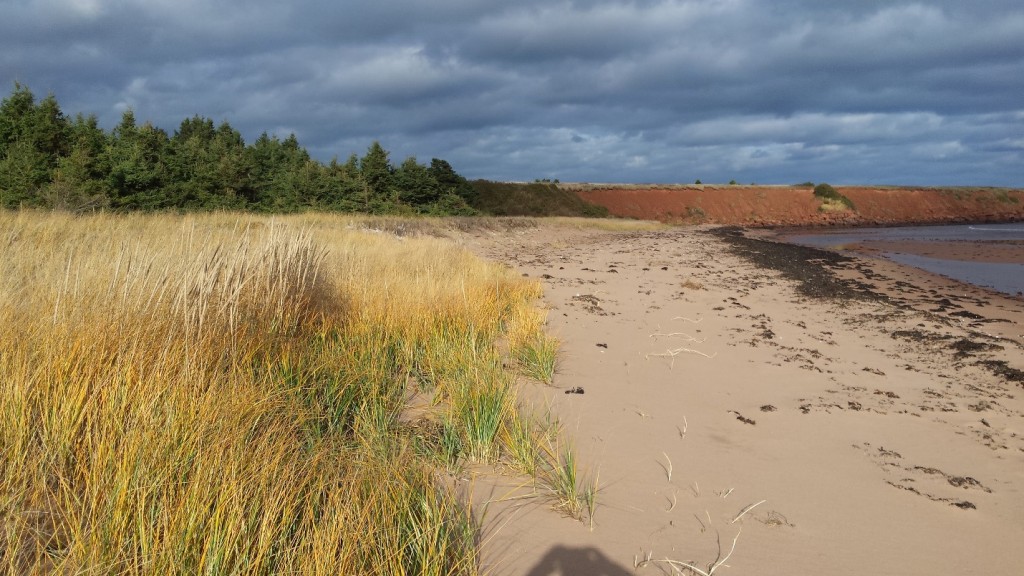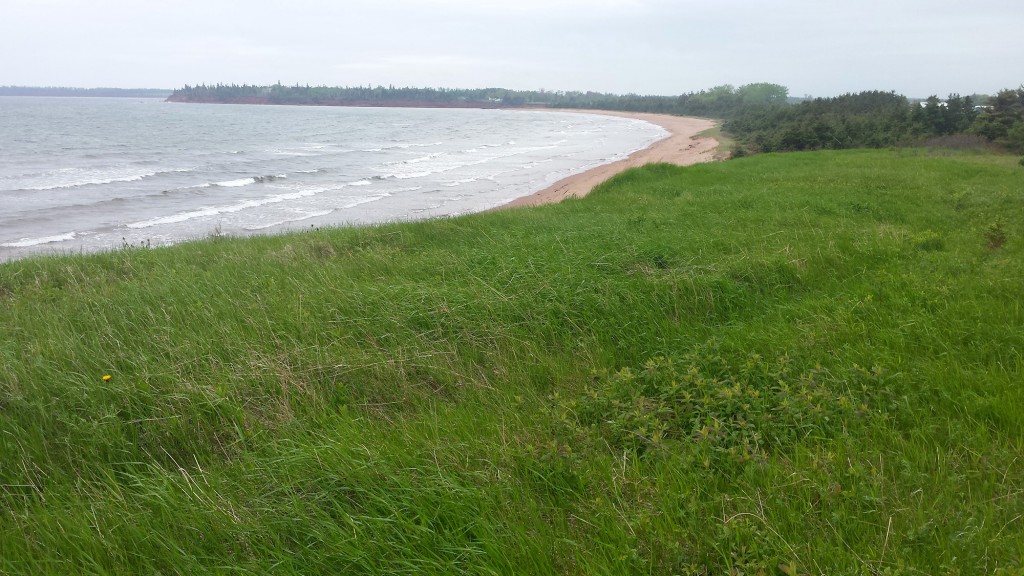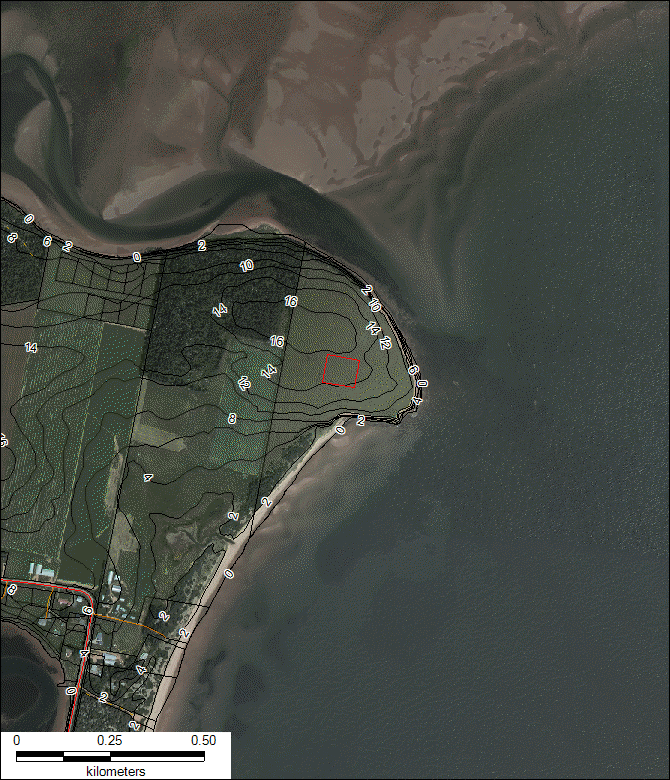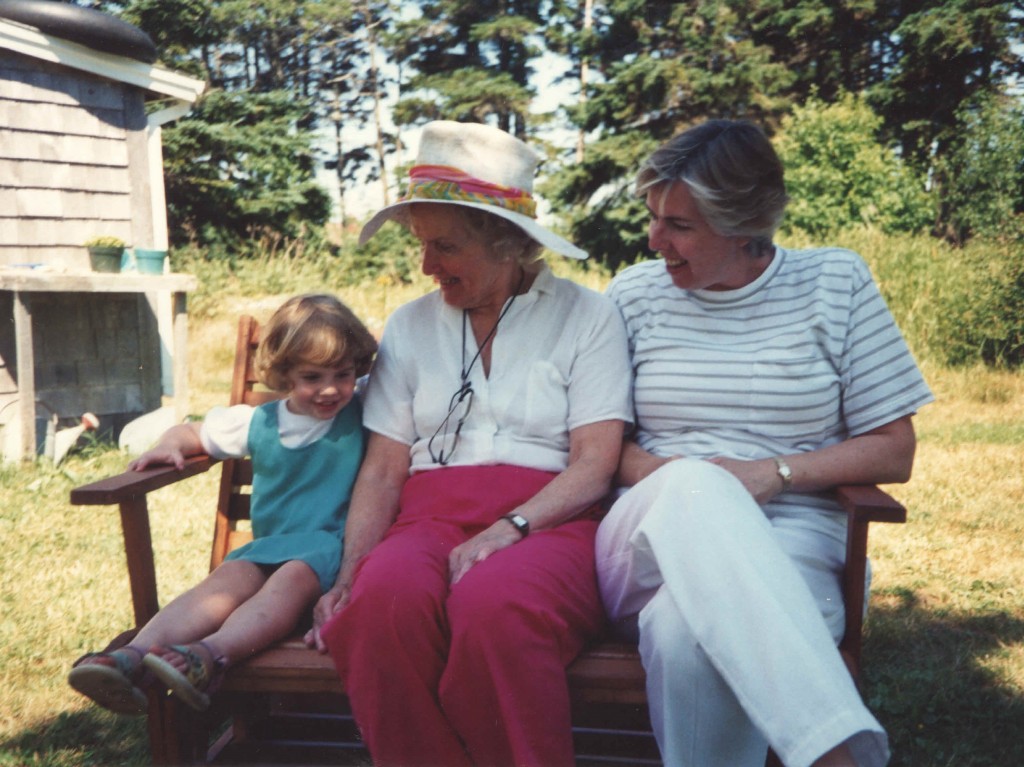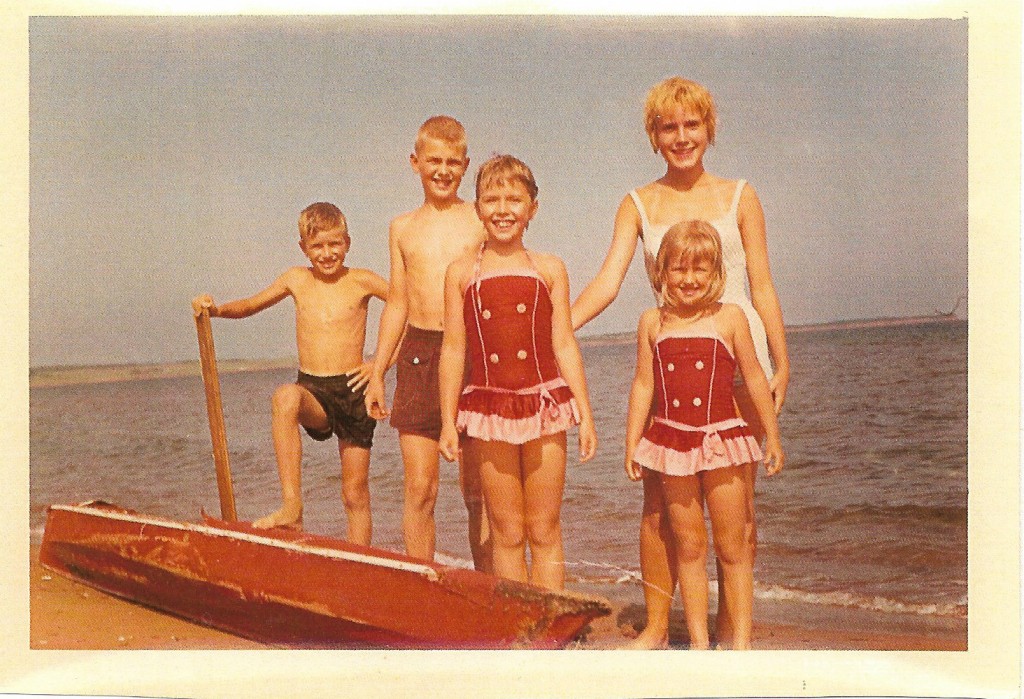15 hectares (37 acre) property serves as a natural coastal buffer for species-at-risk such as the Piping Plover.
A coastal headland including ecologically important and fragile beach-dune habitat will now be protected forever. The peninsula, named Penny’s Point Natural Area, is located within the Rollo Bay Wildlife Management Area and is on the south point at the mouth of Rollo Bay. It was transferred to Island Nature Trust for perpetual stewardship in December, through a most generous and thoughtful donation. Land donors Tom Welch, Anne Lambert and Nancy Willis were resolved to see this coastline remain in a natural state forever.
The property is a highly significant sliver of the PEI coastline, which is under continued threat from erosion and wildlife displacement due to human encroachment. Penny’s Point is part of the northeastern shoreline that hosts some of the best examples of sand dune and beach systems in the Atlantic Maritime ecozone. Prince Edward Island has experienced high historic rates of habitat loss to agriculture and other development. Although natural forest cover is about 50%, remaining habitat patches are generally small, fragmented and degraded. The acquisition of this property will allow Island Nature Trust to conserve vulnerable beach-dune and coastal bluff ecosystems while restoring the land back to native coastal krummholz forest, dominated by the Island’s red oak and other native hardwoods. The sandstone bluffs exceed 10m in height and may provide suitable habitat for burrow occupants such as threatened bank swallow, in addition to belted kingfisher. The beach-dune area within and immediately adjacent the property’s southeast corner is identified as critical habitat for endangered piping plover.
“PEI’s multi-hued coastline is a dynamic and wild natural boundary between land and sea. Our ability to retain pockets of shore in a natural state translates directly to a healthier, more robust ecosystem that will provide for wildlife and people alike long into the future.” – Megan Harris, Executive Director Island Nature Trust
Penny’s Point has been named after land donor Tom Welch’s mother Jane Coyne, who was fondly known as ‘Penny’. His family’s love of PEI wildlife flourished over the decades as they vacationed to the Island every summer starting in the 1950’s.
As a youngster Tom and his siblings enjoyed creeping through coastal forest that existed before being cleared for farmland, to watch from high ground the seals sunbathing on the Rollo Bay sand bars at low tide.
“Penny would have been thrilled to know that the headland is now protected forever. We spent 60 years travelling to Fortune and she loved the area so much. She was concerned about the looming threat of development since our family observed first-hand the surrounding area being steadily built on over the decades.” – Tom Welch
Becoming a staunch supporter of conservation, Tom along with his wife Anne Lambert founded the International Conservation Fund of Canada (ICFC) in 2007 after recognizing that Canada lacked a charitable organization through which Canadians could conserve tropical nature and the winter habitats of Canada’s migratory birds.
This project has been made possible by the land donors, stewardship donations from generous Islanders and funding from the ECHO Foundation and by the Government of Canada through the Natural Heritage Conservation Program, part of Canada’s Nature Fund.
Additional Quotes
“By working with partners like Island Nature Trust and landowners like Tom Welch, Anne Lambert, and Nancy Willis, we are protecting Canada’s iconic natural landscapes in Prince Edward Island, such as the vulnerable beach-dune and coastal-bluff ecosystems. It’s projects across the country, like this one, that support the recovery of important species at risk, help fight climate change, and contribute toward our goal of protecting a quarter of land in Canada by 2025.” – The Honourable Jonathan Wilkinson, Minister of Environment and Climate Change
“Protecting iconic Island landscapes like the beach dunes and coastal bluffs found in Penny’s Point is good news, both for our community and for the species who call it home. Very grateful to the generous land donors and the Island Nature Trust for making today’s announcement possible, and for conserving Penny’s Point for generations to come.” – The Honourable Lawrence MacAulay, Member of Parliament for Cardigan
Quick Facts
• The core area of the property is the coastal cliff and dune. It is 37 acres (15 hectares) in size with 3,800 feet (1,158 meters) of shore frontage, 1000 feet of which is beach.
• The Atlantic Maritime ecozone is characterized by mixed-wood Acadian (Wapan’ekati) forests, sand dunes, and coastal islands. These systems, combined with ocean waters that, during the summer, are the warmest ocean waters in Canada, make them ideal recreational sites.
• The site is one of only two owned by INT that hosts habitat essential for Piping Plover nesting– a species-at-risk on PEI.
• The Rollo Bay Wildlife Management Area is the 6th largest conservation area in PEI and is 526 hectares/1,300 acres in size.
• The Province of Prince Edward Island has set a target of 7% of the landmass or 86,000 acres of natural areas to be protected by 2020.
• Fortune Bridge was and continues to be an important ancestral burial ground for Acadians.
• For the Mi’kmaq Peoples of Prince Edward Island, Fortune Bridge has cultural importance including the harvesting of fish, birds, medicinal plants, and shellfish (Specifically: the fish harvesting of eels, trout, smelts; bird harvesting of ducks, geese; decorative and medicinal plant harvesting; and shellfish harvesting of oysters along the Fortune River). On the land, Traditional Mi’kmaq use of the area includes feather gathering, campsites, and berry gathering.
About
Island Nature Trust is a membership-based, non-government, Canadian charity dedicated to land conservation in Prince Edward Island since 1979.
We envision a network of protected natural areas across PEI sustained by the love and generosity of Islanders today for the enjoyment of Islanders and wildlife tomorrow.
The Government of Canada’s Natural Heritage Conservation Program (NHCP) is a unique public-private partnership to support new protected and conserved areas by securing private lands and private interests in lands. The program is managed by the Nature Conservancy of Canada (NCC). Federal funds invested in the program are matched with contributions raised by NCC and its partners, Ducks Unlimited Canada and the country’s land trust community. Private regional and community land trusts, of which Island Nature Trust is one, access a portion of funds from this program to protect ecologically significant land across Canada.
Links
Facebook: https://www.facebook.com/islandnaturetrust/posts/3870999672961243
Instagram: www.instagram.com/islandnaturetrust/
Contacts
Ben Russell
Communications Manager
902-892-7513 or 902-566-9150
ben@islandnaturetrust.ca
Tom Welch – Land donor
902-980-0277
Nancy Willis – Land donor
902-367-0390 or 902-969-0084
Three generations of the Welch family: Pictured in 1991: Jane ‘Penny’ (middle), daughter Sarah (right) and grandaughter Brennen. Pictured at the property in 1958: (L-R) Siblings Jim, Tom, Sarah and Margot Welch with babysitter Robin Thomson (behind)
Côte iconique sauvé du développement à Fortune Bridge
Propriété de 15 hectares (37 acres) est un tampon naturel pour les espèces en péril comme le Pluvier siffleur
Une promontoire littoral, qui inclut d’habitat importante et fragile de plage-dune, sera maintenant protégée pour toujours. La péninsule, nommée Penny’s Point Natural Area, est située dans Rollo Bay Wildlife Management Area, qui est trouvée au point sud, à l’entrée de Rollo Bay. C’était transférée à Island Nature Trust pour l’intendance perpétuelle en décembre, grâce d’un don généreux.
Le propriété est une partie très significatif de la côte de Î-P-É, qui est dessous une menace continuelle de l’érosion et du déplacement de la faune, en raison d’empiètement humain. Penny’s Point est partie de la côte nord-est, qui représente certains des meilleurs exemples des dunes de sables et systèmes de plage dans l’écozone des Maritimes Atlantiques. L’Île-du-Prince-Édouard à expérimenté historiquement des taux de la perte d’habitat en raison d’agriculture et d’autre développement. Bien que le couvert forestier est naturellement 50%, l’habitat qui reste est normalement petit, fragmenté, et dégradé. L’acquisition de ce propriété permet à Island Nature Trust de conserver les écosystèmes vulnérables de plage-dune et promontoire côtière, en même temps qu’ils restaurent la terre à son original du forêt ‘krummholz’, dominé par le chêne rouge et d’autres arbres décidues. Des falaise grès sont plus que 10m en hauteur et peuvent fournir l’habitat convenable pour les espèces qui creusent leurs nids, comme le menacé, l’Hirondelle de rivage, listé sur la Loi sur les espèces en péril du Canada, en plus que le Martin-pêcheur d’Amérique. La zone plage-dune en dedans et immédiatement à côté du coin sud-est du propriété est identifiée comme l’habitat critique pour le Pluvier siffleur qui est une espèce en voie de disparition sur la liste de la Loi sur les espèces en péril du Canada.
« La côte littoral multicolore de l’Î-P-É est dynamique et sert comme une frontière sauvage et naturel entre la terre et la mer. Notre aptitude de retenir des poches de côte dans un état naturel contribue directement à un écosystème plus sain qui peut fournir pour la faune et des personnes loin dans l’avenir. »
Penny’s Point est nommé après la mère à Tom Welch, qui a fait don de la terre. Elle était reconnu affectueusement comme ‘Penny’. L’amour de sa famille pour la faune à Î-P-É a fleuri depuis des décennies quand ils sont venus chaque été pour les vacances, commençant dans les cinquantaines.
Comme un jeune, Tom et ses frères et sœurs s’amusaient de ramper dans la forêt côtière qui existait avant que la terre a été défrichée pour l’agriculture. De haut, ils ont regardé des phoques qui bronzaient sur les barres de sables à marée basse à Rollo Bay.
« Penny aurait été ravie de savoir que le promontoire littoral est maintenant protéger pour toujours. On a passé des années voyager à Fortune et elle aimait tellement l’endroit. Elle était concernée pour la menace de développement depuis que nous avons observés directement l’endroit autours être développer pour les décennies. » – Tom Welch
Devenir un fervent partisan de la conservation, Tom et sa marie, Anne Lambert, ont fondé Le Fond International de la Conservation du Canada (FICC) en 2007 après avoir remarqué que le Canada manquait une organisation caritative grâce auquel les Canadien(ne)s pouvaient conserver la nature tropicale et des habitats d’hiver pour les oiseaux migratoires en Canada.
Ce projet est possible grâce aux donateurs de terre, dons d’intendance généreux des habitants de l’Île, et de l’aide financière de la fondation ECHO, aussi bien que le Gouvernement du Canada à travers de la Programme de conservation du patrimoine naturel, qui est une partie des Fonds de la nature du Canada.
Citations supplémentaires
« En collaborant avec des partenaires comme Island Nature Trust et des propriétaires fonciers comme Tom Welch, Anne Lambert et Nancy Willis, nous protégeons les paysages naturels emblématiques canadiens de l’Île-du-Prince-Édouard, notamment les écosystèmes fragiles constitués de dunes littorales et d’escarpements côtiers. La réalisation de tels projets au pays contribue au rétablissement d’importantes espèces en péril, à la lutte contre les changements climatiques et à la concrétisation de notre objectif qui consiste à protéger un quart des terres au Canada d’ici 2025. » – L’honorable Jonathan Wilkinson, ministre de l’Environnement et du Changement climatique
« La protection des paysages emblématiques de l’Île, comme les dunes sur les plages et les escarpements côtiers de la pointe Penny, est une bonne nouvelle tant pour notre communauté que pour les espèces qui y vivent. Nous sommes très reconnaissants envers les généreux donateurs de terres et Island Nature Trust, qui ont rendu l’annonce d’aujourd’hui possible et qui font en sorte que la pointe Penny soit conservée pour les générations à venir. » – L’honorable Lawrence MacAulay, député de Cardigan
Les Faits Rapides
- L’endroit principale de la propriété est la falaise côtière et dune. Il comprend 37 acres (15 hectares) avec 3,800 pieds (1,158 mètres) de façade littorale, dont 1000 pieds est la plage.
- L’Écozone d’Atlantique Maritime est caractérisée par les forêts bois mixtes Acadiens (Wapan’ekati), les dunes de sable, et les îles côtières. Ces systèmes, combinées avec les eaux océaniques qui, durant l’été, sont les plus chaudes au Canada, sont des sites de récréations idéales.
- Le site est un de deux appartenant à INT qui montre l’habitat essentiel pour les nids de Pluvier siffleur, une espèce en péril à Î-P-É.
- Le Rollo Bay Wildlife Management Area est le 6ième plus gros endroit de conservation en Î-P-É, avec 526 hectares/1,300 acres de superficie.
- La province de l’Île-du-Prince-Édouard a fixé un objectif de protéger 7% des milieux naturels, ou 86,000 acres, par l’année 2020.
- Fortune Bridge était, et continue d’être, une cimetière ancestral importante pour les Acadiens.
- Pour les Mi’kmaq de l’Île-du-Prince-Édouard, Fortune Bridge a une importance culturelle, incluant la récolte des poissons (anguilles, truites, éperlans), oiseaux (canards et oies), plantes médicinales et décoratives, et crustacés (huîtres). En plus, l’utilisation traditionnelle de la terre comprend rassemblement des plumes et les baies, et les sites de camping.
Au sujet de
Island Nature Trust est une organisation caritative Canadienne non-gouvernementale basée sur des membres. C’est dévouée de conserver la terre à l’Île-du-Prince-Édouard depuis 1979. Nous envisageons un réseau d’endroits naturels protégés à travers l’Î-P-É, soutenu par l’amour et générosité des habitants de l’Île aujourd’hui pour l’amusement des personnes et la faune dans le futur.
La Programme de conservation du patrimoine naturel Canadienne est un partenariat unique public-privé qui soutien les nouveaux milieux protégés et conservés par sécuriser des propriétés privées et des intérêts privés dans les propriétés. La programme est géré par la Conservation de la nature Canada (CNC). Les fonds fédérales investis dans la programme correspondent avec les contributions amassés par CNC et ses partenariats, Canards Illimités Canada et la communauté Canadienne des organismes de conservation. Les organismes de conservations privées et régionales, dont Island Nature Trust est une, accèdent une portion des fonds de la programme pour protéger les propriétés écologiquement significatif à travers le Canada.
En Savoir Plus
Visitez-nous au www.islandnaturetrust.ca
Facebook: https://www.facebook.com/islandnaturetrust/posts/3870999672961243
Instagram: www.instagram.com/islandnaturetrust/
Les Contacts
Ben Russell
Chef de Communications
902-892-7513 or 902-566-9150
ben@islandnaturetrust.ca
Tom Welch – Donateur de terres
902-980-0277
Nancy Willis – Donateur de terres
902-367-0390 or 902-969-0084
